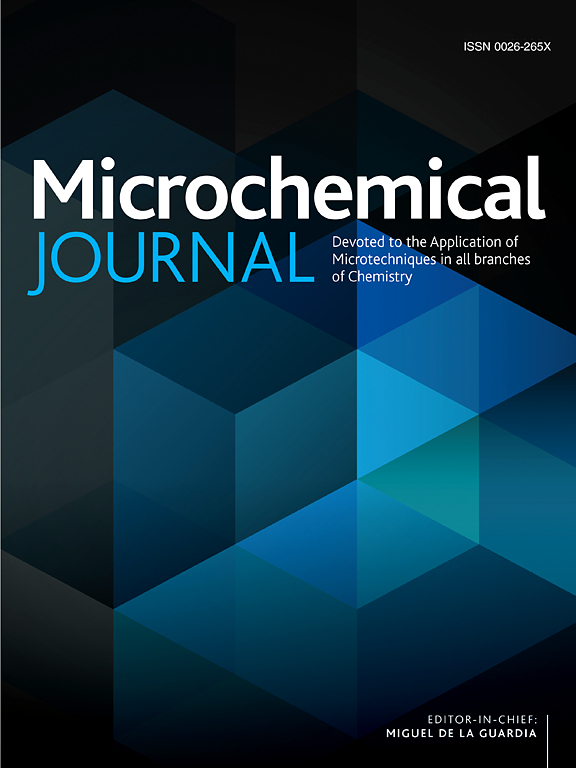灵敏比色法和比例l-精氨酸探针用于智能手机检测和活卵成像
IF 4.9
2区 化学
Q1 CHEMISTRY, ANALYTICAL
引用次数: 0
摘要
鉴于l -精氨酸(Arg)在人类和生物中的重要性,有必要开发有效的检测方法。本文以经济的衬底为原料,通过简单的合成工艺,研制了一种新型比色比比型精氨酸探针L1。D-π-A结构具有较大的共轭体系,使其在紫外和荧光中具有较大的斯托克斯位移和明显的颜色变化。该双信号传感器具有优良的比色灵敏度,检出限(LOD, S/N = 3)为57.91 nM,无需任何仪器即可实现精氨酸的定量检测。该探针具有较高的选择性和荧光灵敏度,检测限为131.5 nM。同时,在2分钟内的短响应时间使其能够立即检测到Arg。通过多种方式研究了其结合机理,job’s图显示L1与Arg的化学计量比为2:1,通过1H NMR滴定实验和理论计算认为脱质子和分子间氢键的协同作用是主要的相互作用。得到了L1和2L1 + Arg配合物的前沿轨道分布及其各自的能量,减少的能隙与吸收峰的红移相对应。基于这些优异的识别性能,探针L1不仅可以作为智能手机中各种食物中便捷的精氨酸检测传感器,还可以应用于活的medaka受精卵成像。本文章由计算机程序翻译,如有差异,请以英文原文为准。
Sensitive colorimetric and ratio l-arginine probe for smartphone detection and living roe imaging
Owing to the importance of L-Arginine (Arg) in humans and organisms, it is necessary to develop efficient methods to detect it. In this article, a novel colorimetric and ratio Arg probe L1 was developed via a simple synthetic process from economical substrates. The D-π-A structure having a large conjugated system endowed it with the high performance of large Stokes shift and obvious color changes both in its UV and fluorescence. The dual-signal sensor was constructed with excellent colorimetric sensitivity with the detection limit (LOD, S/N = 3) of 57.91 nM, which can realize the detection of Arg for qualitative analysis without any instrument. Besides, the probe also has relatively great selectivity and fluorescence sensitivity with the detection limit of 131.5 nM. Meanwhile, the short response time within 2 min allowed it to detect Arg immediately. The binding mechanism was also investigated by various ways, job’s plots indicated a 2:1 stoichiometric ratio of L1 with Arg, and the synergistic effects of deprotonation and intermolecular hydrogen bonding are considered as the primary interactions through 1H NMR titration experiments and theoretical calculation. The frontier orbitals distribution and their respective energies of L1 and 2L1 + Arg complex were obtained too, the reduced energy gap corresponded with the red shift of the absorption peak. Based on these excellent recognition behavior, probe L1 was not only used as the convenient Arg detection sensor in various food by a smartphone, but also applied in the living fertilized medaka egg imaging.
求助全文
通过发布文献求助,成功后即可免费获取论文全文。
去求助
来源期刊

Microchemical Journal
化学-分析化学
CiteScore
8.70
自引率
8.30%
发文量
1131
审稿时长
1.9 months
期刊介绍:
The Microchemical Journal is a peer reviewed journal devoted to all aspects and phases of analytical chemistry and chemical analysis. The Microchemical Journal publishes articles which are at the forefront of modern analytical chemistry and cover innovations in the techniques to the finest possible limits. This includes fundamental aspects, instrumentation, new developments, innovative and novel methods and applications including environmental and clinical field.
Traditional classical analytical methods such as spectrophotometry and titrimetry as well as established instrumentation methods such as flame and graphite furnace atomic absorption spectrometry, gas chromatography, and modified glassy or carbon electrode electrochemical methods will be considered, provided they show significant improvements and novelty compared to the established methods.
 求助内容:
求助内容: 应助结果提醒方式:
应助结果提醒方式:


